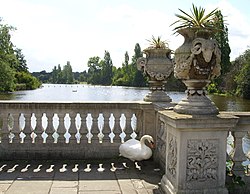The Long Water
| The Long Water | |
|---|---|

The Long Water from the Italian Garden
|
|
| Location | London, England |
| Coordinates | 51°30′27″N 0°10′28″W / 51.507378°N 0.174444°WCoordinates: 51°30′27″N 0°10′28″W / 51.507378°N 0.174444°W |
| Type | Artificial lake |
| Primary inflows | Three boreholes from the upper chalk |
| Primary outflows | Storm Relief Sewer |
| Basin countries | England |
The Long Water is a recreational lake in Kensington Gardens, London, England, created in 1730 at the behest of Queen Caroline. The Long Water refers to the long and narrow western half of the lake that is known as the Serpentine. Serpentine Bridge, which marks the boundary between Hyde Park and Kensington Gardens, also marks the Long Water's eastern boundary.
The Long Water and the Serpentine are generally considered to be part of one lake.
Originally the lake was fed by the River Westbourne entering at the Italian Garden at the north-western end of the Long Water. The Westbourne ceased to provide the water for the Serpentine in 1834, as the river had become polluted, and so water was then pumped from the Thames. The water is now supplied by three boreholes drilled into the Upper Chalk. The first borehole is located at the Italian Gardens, the second at the Diana Memorial and the third, drilled in 2012 to a depth of 132m, is within 50m of the Diana Memorial. The Long Water runs south-east from this point to Serpentine Bridge, where the lake curves to the east, following the natural contours of the land. At the eastern end, water flows out of the lake via a sluice in the dam, forming a small ornamental waterfall at the Dell. The outflow has not historically maintained the waterfall, and re-circulation pumps were installed in the Dell, below the dam, to sustain this feature. The restoration work in 2012 restored the flows into the Serpentine and this waterfall is now restored as originally designed. Historically the river flowed due south from this point, marking the boundary between Westminster and Kensington, but since 1850 it has been diverted into a culvert, running underground to reach the Thames near Chelsea Bridge.
The lake as a whole (including the Serpentine) has a maximum depth of 17 feet (5.3 m). The lake is often reported to be deeper, but bathymetric surveys by the Royal Park in 2010 revealed the design of the lake.
In 1730 Queen Caroline, wife of George II, ordered the damming of the River Westbourne in Hyde Park as part of a general redevelopment of Hyde Park and Kensington Gardens. Original monastic ponds may have existing in the location and these were modified as part of the 1730–1732 scheme to create a single lake. At that time, the Westbourne formed eleven natural ponds in the park. During the 1730s, the lake filled to its current size and shape. The redevelopment was carried out by Royal Gardener Charles Bridgeman, who dammed the Westbourne to create the artificial lake, and dug a large pond in the centre of Kensington Gardens (The Round Pond) to be a focal point for pathways in the park.
...
Wikipedia
